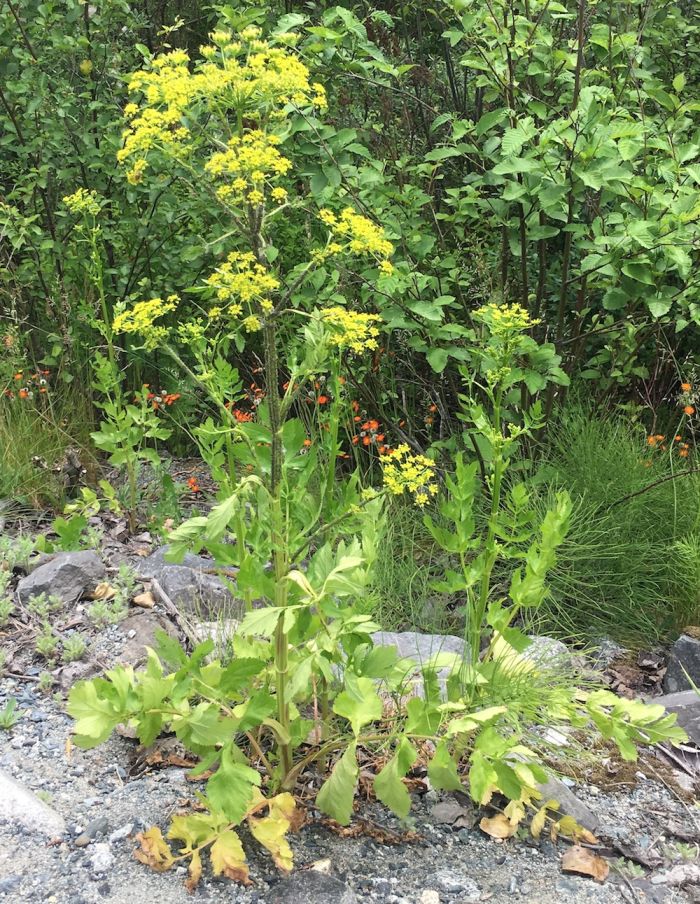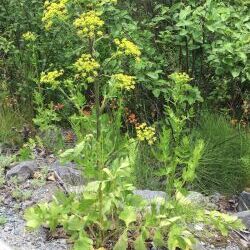
Priority: Eradicate
General: Highly toxic, wild version of the agriculture parsnip plant. It is in the carrot family.
Height: Grows between 0.5 to 1.5m tall.
Flowers: Yellow flowers grow at the top of the plant in an umbrella shape. Each flower is very small with 5 petals.
Leaves/Stems: The stem is light green and deeply grooved. Leaves are approximately 15cm in length with saw toothed edges. Leaves have leaflets that grow across from each other on the stem. There are 2-5 pairs of leaflets with a diamond-shaped one at the end. Young plants have leaves that resemble mittens.
Root: Taproot. It looks like the parsnip that you’d buy in the grocery store.
Bird’s Nest, Common Parsnip, Poison Parsnip, Hart’s Eye
In the Lillooet region, Cow Parsnip (Heracleum maximum) would mostly like be confused with wild parsnip. Other look alikes include Giant Hogweed (Heracleum mantegazzianum), Queen Anne’s Lace (Daucus carota) Angelica (Angelica spp.).
Differences: You can tell the difference between most of the look alikes and Wild Parnsip by the flower colour. Wild parsnip has yellow flowers and the rest are white (Angelica has greenish-white).
Where did it come from? Introduced from European settlers. It was brought to Canada in the early 1600’s.
Where does it grow here? It grows in a variety of soil types and prefers exposed, full sun areas. It can be found on disturbed sites like roadsides, agriculture fields and watercourses. It has been found in a restored wetland area in Lillooet.
Reproduction: Only by seed. One plant can produce 975 seeds.
When does it grow, flower & seed? Sprouts April-May. Flowers Spring-early Summer. Seeds August-September. This plant takes 2-3 years to mature and flower. It spends its first year (s) as a small plant growing lower to the ground (described as a basal rosette).
Spreads By: Seeds are moved by wind, water, mowing equipment or soil movement.
Plant Type: Monocarpic perennial. This is a type of plant that flowers once in its life, produces seed and dies.
- WARNING: This is a highly toxic plant. If the sap from this plant gets on human skin, and then exposed to sunlight, it can cause burns, blisters and rashes. Full sun is not necessary to cause a reaction. NEVER touch this plant without full protective clothing including safety glasses or face shield.
- Wild Parsnip can invade disturbed areas such as roadsides, crop lands and pastures.
- Honeybees do not visit this plant. It displaces other pollinator-friendly native plants.
- Livestock can experience weight loss and fertility issues if they ingest Wild Parnsip.
- Review your property regularly for this species and watch for it in other areas. REPORT all Sightings!
- Treatment WARNING-Use full protective gear: eye & clothing if you choose to remove this plant. Remove small patches before it flowers & sets seed. Full treatment recommendations can be found in the Ontario Best Management Guide. Note that there are different regulations for BC for treatment methods.
- Cover bare patches or disturbed soil by planting or seeding with non-invasives.
- Check areas where you have removed invasives for any new plants that year and in future growing seasons.
- Dispose of invasive plants responsibly. Bag them for disposal at the local landfill. Ensure the bags are closed securely. Composting and burning are not recommended.
- Contact LRISS for specific treatment recommendations.
Tassie, Danielle and Sherman, Kellie. 2014. Invasive Wild Parsnip (Pastinaca sativa) Best Management Practices in Ontario. Ontario Invasive Plant Council, Peterborough, ON.
